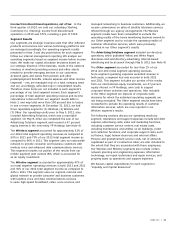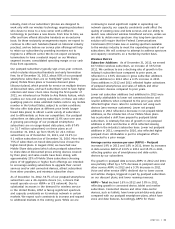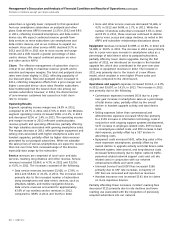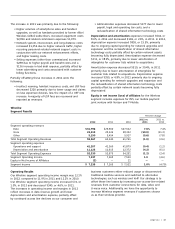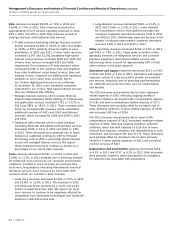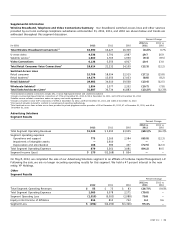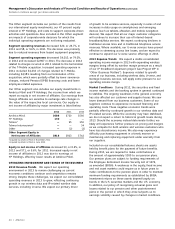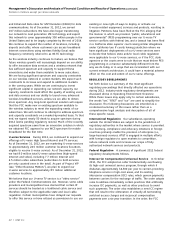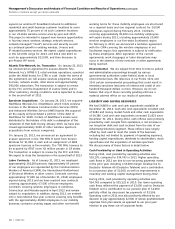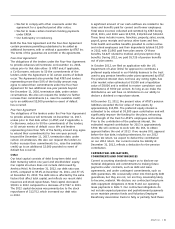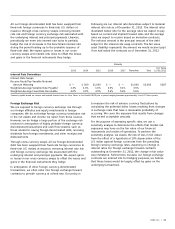AT&T Wireless 2012 Annual Report Download - page 45
Download and view the complete annual report
Please find page 45 of the 2012 AT&T Wireless annual report below. You can navigate through the pages in the report by either clicking on the pages listed below, or by using the keyword search tool below to find specific information within the annual report.
AT&T Inc. | 43
who offer voice, text messaging and other services as
applications on data networks. More than 97 percent of the
U.S. population lives in areas with at least three mobile
telephone operators, and 90 percent of the population lives
in areas with at least five competing carriers.
The FCC may develop rules to auction or otherwise make
available additional spectrum to the wireless industry.
The FCC has indicated it plans to conduct an auction in
2014 under which up to 120 MHz of UHF TV spectrum could
be reallocated for mobile wireless use. In addition, the FCC
is required by law to auction up to 65 MHz of additional
wireless spectrum in 2015. The FCC has yet to develop the
rules under which this spectrum might be available. We may
experience significant competition from companies that
provide similar services using other communications
technologies and services. While some of these technologies
and services are now operational, others are being developed
or may be developed. We compete for customers based
principally on service/device offerings, price, call quality,
coverage area and customer service.
Wireline
Our wireline subsidiaries expect continued competitive
pressure in 2013 from multiple providers, including wireless,
cable and other VoIP providers, interexchange carriers and
resellers. In addition, economic pressures are forcing
customers to terminate their traditional local wireline service
and use competitive wireless and Internet-based services,
intensifying a pre-existing trend toward wireless and Internet
use. In most markets, we compete, often on pricing of
bundled services, with large cable companies, such as
Comcast Corporation, Cox Communications Inc. and Time
Warner Cable Inc., for local, high-speed Internet, video
and voice services customers and other smaller
telecommunications companies for both long-distance
and local services customers.
Our wireline subsidiaries generally remain subject to
regulation for wholesale services by state regulatory
commissions for intrastate services and by the FCC for
interstate services. Under the Telecom Act, companies
seeking to interconnect to our wireline subsidiaries’ networks
and exchange local calls enter into interconnection
agreements with us. Any unresolved issues in negotiating
those agreements are subject to arbitration before the
appropriate state commission. These agreements (whether
fully agreed-upon or arbitrated) are then subject to review
and approval by the appropriate state commission.
Our wireline subsidiaries operate under state-specific forms
of regulation for retail services that were either legislatively
enacted or authorized by the appropriate state regulatory
commission. Most states deregulate the competitive services;
impose price caps for some services where the prices for
these services are not tied to the cost of providing the
also repurposed its high-cost universal service program
to encourage providers to deploy broadband facilities in
unserved areas. To accomplish this goal, the FCC will
transition support amounts disbursed through its existing
high-cost program to its new Connect America Fund, which
eventually will award targeted high-cost support amounts to
providers through a competitive process. We support many
aspects of the order and new rules. AT&T and other parties
have filed appeals of the FCC’s rules, which are pending in
the Tenth Circuit Court of Appeals. Our appeal challenges
only certain, narrow aspects of the order; AT&T intervened
in support of the broad framework adopted by the order.
We do not expect the FCC’s rules to have a material impact
on our operating results.
Transition to IP-Based Network In conjunction with
Project VIP (see “Other Business Matters”), AT&T filed a
petition with the FCC asking it to open a proceeding to
facilitate the “telephone” industry’s transition from traditional
transmission platforms and services to all IP-based networks
and services. Our petition asks the FCC to conduct trial runs
of the transition to next-generation services, including
the upgrading of traditional telephone facilities and
offerings and their replacement with IP-based alternatives.
The objective of the trials is to inform policymakers and
other stakeholders regarding the technological and policy
dimensions of the IP transition and, in the process, identify
the regulatory reforms needed to promote consumer interests
and preserve private incentives to upgrade America’s
broadband infrastructure. We expect to transition customers
to an all IP-based network by 2020.
COMPETITION
Competition continues to increase for telecommunications
and information services. Technological advances have
expanded the types and uses of services and products
available. In addition, lack of or a reduced level of regulation
of comparable alternatives (e.g., cable, wireless and VoIP
providers) has lowered costs for these alternative
communications service providers. As a result, we face
heightened competition as well as some new opportunities
in significant portions of our business.
Wireless
We face substantial and increasing competition in all aspects
of our wireless business. Under current FCC rules, multiple
licensees, including six or more PCS licensees, two cellular
licensees and one or more enhanced specialized mobile radio
licensee may operate in each of our service areas, which
results in the potential presence of multiple competitors.
Our competitors include companies such as Verizon Wireless,
Sprint Nextel Corp., T-Mobile, Metro PCS and Cricket, a larger
number of regional providers of cellular, PCS and other
wireless communications services and resellers of those
services. In addition, we face competition from providers


